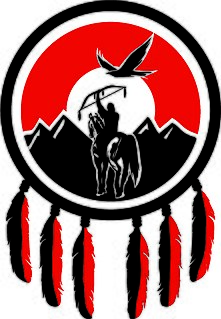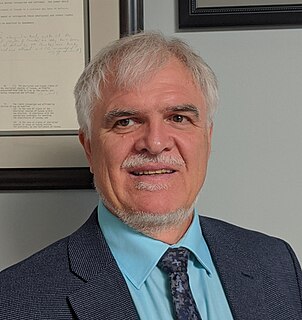
The Tsilhqotʼin or Chilcotin are a North American tribal government of the Athabaskan-speaking ethnolinguistic group that live in what is now known as British Columbia, Canada. They are the most southern of the Athabaskan-speaking Indigenous peoples in British Columbia.

R v Sparrow, [1990] 1 S.C.R. 1075 was an important decision of the Supreme Court of Canada concerning the application of Aboriginal rights under section 35(1) of the Constitution Act, 1982. The Court held that Aboriginal rights, such as fishing, that were in existence in 1982 are protected under the Constitution of Canada cannot be infringed without justification on account of the government's fiduciary duty to the Aboriginal peoples of Canada.
Section 35 of the Constitution Act, 1982 provides constitutional protection to the indigenous and treaty rights of indigenous peoples in Canada. The section, while within the Constitution of Canada, falls outside the Canadian Charter of Rights and Freedoms. The section does not define the term "aboriginal rights" or provide a closed list; some examples of the rights that section 35 has been found to protect are fishing, logging, hunting, the right to land and the right to enforcement of treaties. There remains a debate over whether the right to indigenous self-government is included within section 35. As of 2006 the Supreme Court of Canada has made no ruling on the matter. However, since 1995 the Government of Canada has had a policy recognizing the inherent right of self-government under section 35.

Delgamuukw v British Columbia, [1997] 3 SCR 1010, also known as Delgamuukw v The Queen, Delgamuukw-Gisday’wa, or simply Delgamuukw, is a ruling by the Supreme Court of Canada that contains its first comprehensive account of Aboriginal title in Canada. The Gitxsan and Wet’suwet’en peoples claimed Aboriginal title and jurisdiction over 58,000 square kilometers in northwest British Columbia. The plaintiffs lost the case at trial, but the Supreme Court of Canada allowed the appeal in part and ordered a new trial because of deficiencies relating to the pleadings and treatment of evidence. In this decision, the Court went on to describe the "nature and scope" of the protection given to Aboriginal title under section 35 of the Constitution Act, 1982, defined how a claimant can prove Aboriginal title, and clarified how the justification test from R v Sparrow applies when Aboriginal title is infringed. The decision is also important for its treatment of oral testimony as evidence of historic occupation.

Calder v British Columbia (AG) [1973] SCR 313, [1973] 4 WWR 1 was a decision by the Supreme Court of Canada. It was the first time that Canadian law acknowledged that aboriginal title to land existed prior to the colonization of the continent and was not merely derived from statutory law.

Guerin v The Queen [1984] 2 S.C.R. 335 was a landmark Supreme Court of Canada decision on Aboriginal rights where the Court first stated that the government has a fiduciary duty towards the First Nations of Canada and established Aboriginal title to be a sui generis right.

R v Marshall; R v Bernard 2005 SCC 43 is a leading Aboriginal rights decision of the Supreme Court of Canada where the Court narrowed the test from R. v. Marshall for determining the extent of constitutional protection upon Aboriginal practices. The Court held that there was no right to commercial logging granted in the "Peace and Friendship treaties of 1760", the same set of treaties where the right to commercial fishing was granted in the R. v. Marshall decision. This decision also applied and developed the test for aboriginal title from Delgamuukw v British Columbia.
The Xeni Gwet'in First Nation is a First Nations government located in the southwestern Chilcotin District in the western Central Interior region of the Canadian province of British Columbia. It is a member of the Tsilhqot'in Tribal Council.

Aboriginal title is a common law doctrine that the land rights of indigenous peoples to customary tenure persist after the assumption of sovereignty under settler colonialism. The requirements of proof for the recognition of aboriginal title, the content of aboriginal title, the methods of extinguishing aboriginal title, and the availability of compensation in the case of extinguishment vary significantly by jurisdiction. Nearly all jurisdictions are in agreement that aboriginal title is inalienable, and that it may be held either individually or collectively.
The British Columbia Treaty Process (BCTP) is a land claims negotiation process started in 1993 to resolve outstanding issues, including claims to un-extinguished indigenous rights, with British Columbia's First Nations.

Nemaiah Valley, also spelled Nemiah Valley and Nemaia Valley, is an unincorporated locality and First Nations reserve and ranching community between Chilko Lake and the Taseko Lakes in the Chilcotin District of the Central Interior of British Columbia.

The Tsilhqot'in National Government (TNG), is the official First Nations government serving the Tsilhqot'in Nation. Their office is located in Williams Lake, British Columbia, Canada. The member communities represented by TNG are ʔEsdilagh, Tsi Del Del, Yunesit'in, Tl'etinqox, Xeni Gwet'in, and Tl'esqox. Tl'esqox also belongs to the Carrier-Chilcotin Tribal Council, as does Ulkatcho - a community with both Dakelh (Carrier) & Tsilhqot'in heritage. TNG was established in 1989.
The lack of treaties between the First Nations of British Columbia (BC) and the Canadian Crown, is a long-standing problem that has become a major issue in recent years. In 1763, the British Crown declared that only it could acquire land from First Nations through treaties. Historically only two treaties were signed with the First Nations of British Columbia. The first of which was the Douglas Treaties, negotiated by Sir James Douglas with the native people of southern Vancouver Island from 1850-1854. The second treaty, Treaty 8, signed in 1899 was part of the Numbered Treaties that were signed with First Nations across the Prairie regions. British Columbian Treaty 8 signatories are located in the Peace River Country or the far North East of BC. For over nine decades no more treaties were signed with First Nations of BC; many Native people wished to negotiate treaties, but successive BC provincial governments refused until the 1990s. A major development was the 1997 decision of the Supreme Court of Canada in the Delgamuukw v. British Columbia case that Aboriginal title still exists in British Columbia and that when dealing with Crown land, the government must consult with and may have to compensate First Nations whose rights are affected.

Paul v British Columbia , 2003 SCC 55, is a leading Supreme Court of Canada decision in administrative law and aboriginal law. The case stands for the proposition that a provincial administrative actor granted the power to determine questions of law may adjudicate matters within federal legislative competence, including s. 35 aboriginal rights matters.

Haida Nation v British Columbia , [2004] 3 S.C.R. 511 is the leading decision of the Supreme Court of Canada on the Crown duty to consult Aboriginal groups prior to exploiting lands to which they may have claims.

Daniels v Canada , 2016 SCC 12 is a case of the Supreme Court of Canada, which ruled that Métis and non-status Indians are "Indians" for the purpose of s 91(24) of the Constitution Act, 1867.
In Canada, the duty to consult and accommodate with Aboriginal peoples arises when the Crown contemplates actions or decisions that may affect Aboriginal or Treaty rights. This duty arises most often in the context of natural resource extraction such as mining, forestry, oil, and gas.

Jack Woodward is a Canadian lawyer. He specialises in Canadian Aboriginal law and is the author of Native Law, which is considered the leading Canadian publication on Aboriginal Law.
In Canada, aboriginal title is considered a sui generis interest in land. Aboriginal title has been described this way in order to distinguish it from other proprietary interests, but also due to the fact its characteristics cannot be explained by reference either to only the common law rules of real property, or to only the rules of property found in Indigenous legal systems. The Supreme Court of Canada has characterised the idea that aboriginal title is sui generis as the unifying principle underlying the various dimensions of that title. Aboriginal title is properly construed as neither a real right nor a personal right, despite the fact that it appears to share characteristics of both real and personal rights. Aboriginal title refers to the concept of a sui generis right in land that originates from the exclusive occupation and use of a specific territory by an aboriginal group over which the group has a native historic attachement.

Grassy Narrows First Nation v. Ontario [2014] SCR 48, [2014] 2 S.C.R. 447 was a July 11, 2014 decision by the Supreme Court of Canada in case number 35379 in which an appeal made by the Government of Ontario was allowed. The result of Grassy Narrows v. Ontario, while legal, was deemed unfair by some to Grassy Narrows First Nation, as "it has put them in a situation of having negotiated with a party who then ceased to be a party when it came to honouring the agreement."






